Between the discovery of Comet ASASSN1 and two stellar explosions, there's a lot happening in the sky this week. Take your telescope out and see what all the excitement's about.
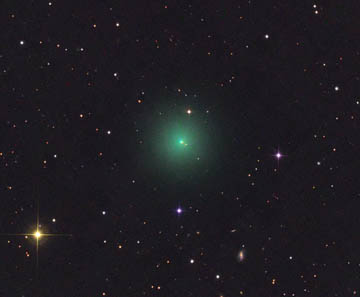
Rolando Ligustri
It feels like the FedEx guy just pulled up and dropped off a truckload of astronomical goodies. News arrived in my e-mail Monday about a new comet discovered by the All-Sky Automated Survey for Supernovae (ASAS-SN). Founding member Benjamin Shappee and team have 498 bright supernovae and numerous other transient sources to their credit, but this is the group's first comet discovery, ASASSN1 (C/2017 O1).
The 15th-magnitude object was caught before dawn on July 19th in the constellation Cetus using data from the quadruple 14-cm "Cassius" telescope on Cerro Tololo, Chile. Don't be put off by that magnitude. The comet has brightened quickly in the past few days; visual observers are now reporting it at around magnitude +10 with a large (7
I concur with Chris. On the morning of July 27.3 UT from near Duluth, Minn., I found the comet large, faint and diffuse in my 10-inch at 57x from Duluth, Minn. The Swan filter gave it a welcome boost. Some fire haze was present in the air at the time which may account for it being fainter than expected. With a coma 8′ across, this thing's big!
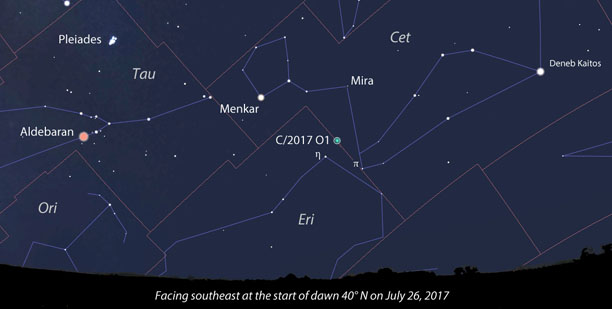
Stellarium
Assuming the orbit remains close to the current calculation, Comet ASASSN1 will move northeast across Cetus and Taurus this summer and fall, slowly brightening as it approaches perihelion on October 14th in Perseus. It comes closest to the Earth four nights later, missing the planet by a cool 67 million miles. In a fun twist, ASASSN1 will slow down and spend the entire month of December and much of January within a few degrees of the North Star!
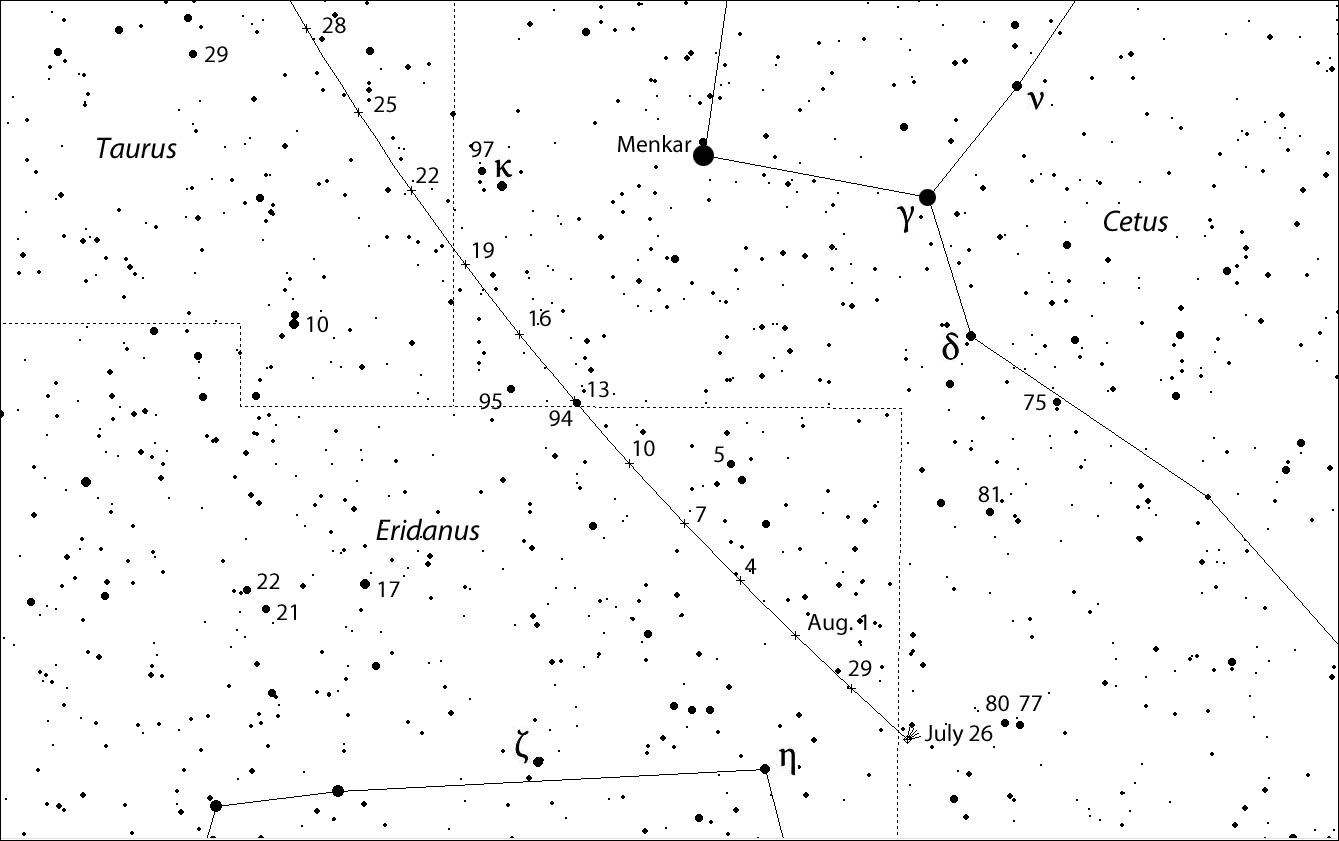
Chris Marriott's SkyMap
Still, don't count your comets before they hatch. Or even after. Hairy stars can be fickle. There's a fair chance we're only seeing a temporary bright outburst of an intrinsically faint comet. But who knows? You and I will have to keep track of it to find out. Right now, ASASSN1 stands about 20° high in the southeastern sky as it crosses from Cetus into Eridanus. An 8-inch telescope should have no problem bringing it to life, especially now that the Moon's out of view and won't return to the morning sky until August 6th. You can stay in touch with the latest developments on Shappee's Twitter page.
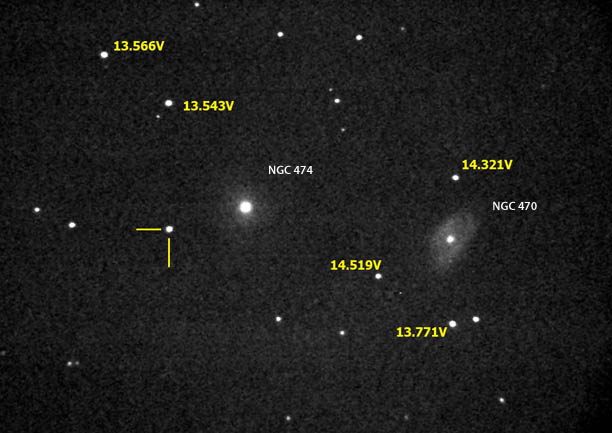
Stan Howerton
While you're out waiting for the comet to climb out of the haze, why not check out the new supernova, SN 2017fgc, which recently exploded into view in the 11th-magnitude galaxy NGC 474 in Pisces. At magnitude +13.7, you wouldn't call it "bright," but it's been rising since the DLT40 Survey discovered it on July 11th. Based on spectra taken of the object, it was still a couple weeks before maximum in mid-July, so I wouldn't be surprised if it continues to brighten.
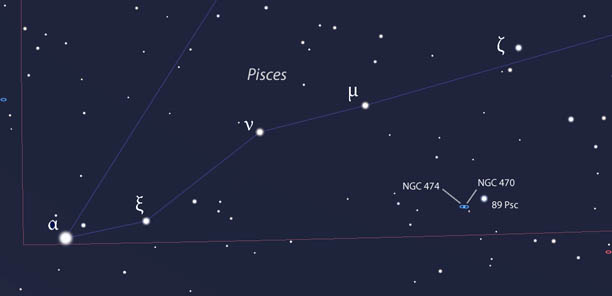
Stellarium
Lots of supernovae appear close to the nuclei of their host galaxies and are notoriously difficult to discern in the dense fuzz of unresolved starlight. Not this one. It's "in the clear" 116″ east and 45″ north of the galaxy's center, so you won't break an eyeball trying to see it. An 8-inch scope magnifying around 150×-200× should coax it into view on a dark, moonless morning. It was very easy to spot at 157x in the 10-inch at magnitude +13.5 on July 27.4 UT. Take a minute with the side-by-side galaxies, a great sight in its own right.
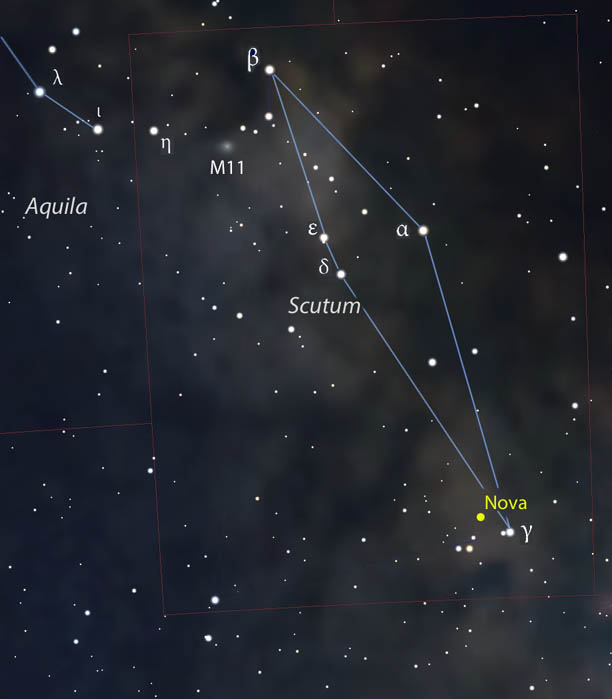
Stellarium
When you bring this catastrophic pinpoint into focus, you'll be looking at what happens when a white dwarf star gains too much weight. After siphoning material from a close companion star for millennia, the dwarf exceeded its maximum weight of 1.4 solar masses and underwent a catastrophic gravitational collapse. The runaway fusion reaction that followed raced through the star, destroying it in one titanic blast. Overnight, a lowly white dwarf became a Type Ia supernova, bright enough to see from 96 million light years, the distance to the host galaxy.

Gianluca Masi / Virtual Telescope Project
Finally, a nova that's been dozing away at 12th-magnitude has started kicking out the jams! Since it's discovery on June 23rd, ASASSN-17hx has brightened nearly two full magnitudes, putting it within range of large binoculars and small telescopes.
As you can tell from the object's name, the ASAS-SN crew has been busy! Currently at about magnitude +9.0 (and still rising) in the Scutum Milky Way, it's well-placed for viewing at nightfall a few degrees below the tail of Aquila, the Eagle.
Like a Type Ia supernova, a nova occurs in a close binary star system where a normal star like our Sun is paired up with a white dwarf. Material pulled from the companion finds its way by way of accretion disk to the surface of the dwarf, where it accumulates, heats up, and ignites in a thermonuclear explosion. A sudden increase in brightness follows on the heels of the blast that raises the star from obscurity to binocular or even naked-eye visibility.
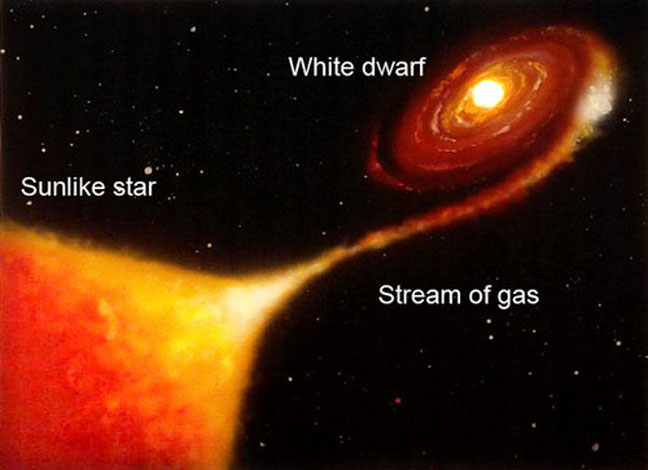
NASA
Unlike a supernova, the dwarf in this system remains intact and the process begins anew. It's estimated that small white dwarfs have repeat nova outbursts about once every 5 million years; for larger dwarfs, it's about every 30,000 years. The most massive must take care as they teeter close to the 1.4-solar mass limit. If a dwarf doesn't burn and destroy the accumulated fuel in time, the extra mass can push it past the limit to supernova-dom.
Guess it's time to open up those packages. Clear skies!
 47
47









Comments
Blaine Dickey
July 26, 2017 at 2:50 pm
Thanks for the timely information! Great article! Now if the weather will co-operate I will enjoy keeping track of these objects.
You must be logged in to post a comment.
Bob KingPost Author
July 26, 2017 at 4:09 pm
Thanks, D-B. I'm hoping for the same cooperation here in Minn!
You must be logged in to post a comment.
Tom-Reiland
July 26, 2017 at 8:04 pm
Bob, I observed the SN in NGC 474 this morning and I estimated it at 13.5, maybe slightly brighter. I observed the Nova in Scutum on the night of July 17-18 and it was 10.7 mag. It was 12.7 on the night of June 27-28. I wanted to stay later to try to locate the comet, but an observer's bane, high humidity, caused me to close up the 21" Scope at Wagman Obs to prevent dew building up on the mirrors. Lots of extra-galactic SN this Summer so far. I count 5 in the past two months that I've been able to spot.
You must be logged in to post a comment.
Bob KingPost Author
July 27, 2017 at 1:23 am
Hi Tom,
Thanks for writing in. I just got back in from observing Nova Scuti and it's quite bright, about 8.8 right now and noticeably "rosy" colored in my 10-inch. I was surprised to see it this bright, figuring it would be closer to 9-9.5.
You must be logged in to post a comment.
Graham-Wolf
July 26, 2017 at 10:33 pm
Hi Bob!
Thrilled to report that I have seen C/2017 O1 ASASSN... Twice this week. Was alerted on July 23rd by both the BAA Comet Section, and Yoshida's Cometsite. Using Yoshida's 2 line 7 day ephedrine, I located a 5 Deg patch near Eta Eri which is Mv 3.85. This placed me some 35 deg above and some 10 deg left of M45. I sure could have used your excellent finder harts at the time! With my Meade 12cm f4 GOTO newt at 100x and 48 arc in for, I used the HP catalogue in Stellarium to obtain Mv 10.0 and DC 3 on the 23rd and 25th, at 0.750 UT. The coma was approx 6 arcmin. I am now located this month on a high suburb in Dunedin. Graham.w.wolf at Dunedin, NZ. Temps ranging from -2 to plus 3 most nights this month.
You must be logged in to post a comment.
Bob KingPost Author
July 27, 2017 at 1:25 am
Thanks so much Graham for dropping by and sharing your ASASSN1 observation. Like you, I was happy to hear of this new discovery as the other comets tha kept us busy this year have either left or begun to fade and drop into the west.
You must be logged in to post a comment.
Graham-Wolf
July 26, 2017 at 10:35 pm
48 arcmin fov. Graham at Dunedin, nz. Will send full data to you, soon. Good hunting with this new comet, folks!
You must be logged in to post a comment.
Graham-Wolf
July 26, 2017 at 10:38 pm
7 day 2 line ephemeris by Yoshida. Apologies for gmail typo uncorrector. It's driving me nuts!!! Graham at Dunedin, nz.
You must be logged in to post a comment.
July 27, 2017 at 6:26 am
Bob, what's your take on the IAU refusing to call this comet after the ASASSN team?
John.
You must be logged in to post a comment.
Bob KingPost Author
July 27, 2017 at 9:52 am
Goodricke,
I hope they change their mind. Other comets are named for surveys, and I think the ASASSN group does exactly the same. They've followed convention, so I don't understand why they're being singled out. Maybe it's a temporary snafu that will be rectified.
You must be logged in to post a comment.
Graham-Wolf
July 27, 2017 at 9:57 pm
Hi Bob.
My C/2017 O1 (ASASSN) data, as recently promised.
Jul 23.750 UT Mv 10.0 6.0 arcmin DC3
Jul 25.750 UT Mv 10.0 6.4 arcmin DC3
Jul 27.778 UT Mv 9.6 8.2 arcmin DC3
All obs done with 12cm f4 Meade GOTO Dob, at 100x (48 arcmin FIOV).
Site = -45.890154 SOUTH, +170.477884 EAST, 142.0m amsl.
HP (Hipparchus) comparisons centred (3df MLim 11) on Eta Eri (Mv 3.85), These are
HIP 13467 Mv 7.85 HIP 13784 Mv 9.95
HIP 13861 Mv 8.40 HIP 13681 Mv 10.20
HIP 13309 Mv 9.55 HIP 13964 Mv 10.50
Great to hear that Chris (Wyatt) has reported in... his data is on Dr Luis Mansilla's LIADA Comet data-site. Good work, Chris!
Sad to hear Bob, about the unpleasant political issues around the full naming of this new comet after the Survey Team. I vividly recall the South African MASTER Team and the Hawaii based PANSTARRS Team both being treated a lot nicer than this....I too, Bob, share your concerns, and hope this is merely a brief IAU foul-up, that will be resolved very quickly. Meanwhile, my heartiest congratulations to the ASASSN Team! Well done. If they hadn't snared it, there's a slim possibility that Terry Lovejoy WOULD have. Such is our united global community out there. It's headed north to a circumpolar sky near Polaris soon. Enjoy!!
Graham W. Wolf at Dunedin, NZ.
You must be logged in to post a comment.
Bob KingPost Author
July 28, 2017 at 10:16 am
Hi Graham,
Great data! Thanks for sharing. I rated the comet at DC=2, but that may be due to lower altitude and that haze I mentioned in the article.
You must be logged in to post a comment.
Graham-Wolf
July 28, 2017 at 8:26 pm
Thanks Bob!
I agree.
Your much lower elevation at Duleth USA, has probably "hazed" the nucleus mildly down to DC2. Gonzalez, Wyatt, and I all get DC3. +/- a single DC is certainly not a crisis. Had another peek just a few hours ago. Skies clear and freezing all night. Ground temps -3 Celsius with air tempo of 0.3 C at 06:20am NZST (Make that July 28.764 UT). Winds dead calm, and R/H of 76%. Brrr. Ruddy green glow of the nucleus is quite similar visually, to that of 41/p T-G-K earlier this year. Maybe we should re-class them as "Irish comets".... hahaha. C/2017 O1 certainly enhances with a Swan filter.... I repeated Chris Wyatt's trick the other day. Soooo..... it's certainly a "gasser" and a "newbie". Awesome photo on your website Bob.... my views were rather fainter:- the pic certainly pulled in a lot of fainter detail, for sure.
The comet zooms quickly northwards towards Polaris over the next 3 months or so. This put you Bob, and your Northern readers, firmly in the box seat. Has it maxed out yet? Not sure. My gut feeling is that this new comet has at least another 2 Mv left to go. Don't expect it to pull naked eye, but if it does.... WOWEE! We'll see. Meanwhile, my latest data.....
JUL 28.764 UT Mv 9.6 8.0 arcmin DC3 12cm f4 L at 100x (48 arcmin FOV).
HIP Comparisons used and Sidgewick "in-out" method. HIP 13861 (Mv 8.40), HIP 13309 (Mv 9.55), HIP 13784 (Mv 9.95), HIP 13681 (Mv 10.20)..... all within 3df of Eta Eri (Mv 3.85).
The site mentioned in my previous post, Bob, has been my new address since July, 5th. What metropolitan light pollution there is, actually lies well below my vantage point. Rather like being on the summit (1032 m) of the famous Mount John National Observatory of NZ at Tekapo, and looking down nearly 300 vertical metres and 2km horizontal into the township.
Best wishes to you and your readers, Bob.
Graham W. Wolf at 46 South N.Z.
You must be logged in to post a comment.
Bob KingPost Author
July 29, 2017 at 11:36 am
Graham,
I also found that the Swan filter helped out. Waiting for the fire haze to clear out more before I go out for another pre-dawn run. Your new observing site sounds fantastic!
You must be logged in to post a comment.
Alain Figer
July 29, 2017 at 1:31 pm
I have been watching the Nova Sct photographically using a 300mm teleobjective at f/2.8 mounted on a Canon EOS 6D. I searched for it on older photos taken before the discovery announcement, but it was too faint. Here are my measurements so far :
21.922 JUN not visible mag > 13.8
01.943 JUL mag 11.7
02.933 JUL mag 11.3
03.890 JUL mag 11.0
13.900 JUL mag 10.8
14.871 JUL mag 10.7
25.892 JUL mag 9.1
A real problem is the choice of convenient comparison stars. I only used a preliminary sequence clearly needing to be improved.
Alain Figer
France
You must be logged in to post a comment.
Bob KingPost Author
July 29, 2017 at 1:49 pm
Hi Alain,
I agree. The AAVSO charts plot few stars in the nova's current range. I found this out the other night when making an estimate. If I recall, the comp stars were 10.7, 9.0 and 6.4 with the 9.0 comp extremely close to a brighter star, making it difficult to use.
You must be logged in to post a comment.
Graham-Wolf
July 29, 2017 at 8:57 pm
Hi Bob
Thanks for the encouragement.
Subhurban summit ridge of a city it certainly IS, Mauna Kea is certainly ISN'T.
Certainly favoured by long spells of frosty sub-zero winter temps.
Latest data this morning, just a few hrs ago.
Same scope, same power, same site.
JUL 29.758 UT Mv 9.6 8.8 arcmin coma DC3,
Same sidgewick brightness as HIP 13309 (9.55) near Eta Eri.
Ground temp -4 deg C. Air temp -0.3 deg C, 2kts NE, 65% R./H.
Regards
Graham
You must be logged in to post a comment.
Tom-Reiland
July 30, 2017 at 6:05 am
I was finally able to observe Comet 2017 O1 this morning. The conditions were not great, but we eventually had a clearing in the ESE and spotted it next to the pair of stars on your chart for 0 hours on July 30. We first saw it at 212X with the Swan Band Filter and then without the filter. Finally at 127X. I'm not going to estimate the magnitude because of the LP in that area of the sky. Earlier, we observed ASASSN-17hx in Scutum. It's at least 9 mag, maybe slightly brighter, but without reference star mags between 8 and 10 mag on the AAVSO Chart, it's hard to get an accurate estimate, The SN in NGC 474 is still close to 13.5, maybe closer to 13.7 mag. Nice to get all three in the same night.
You must be logged in to post a comment.
Bob KingPost Author
July 30, 2017 at 11:42 pm
Nice catches, Tom. Happy to hear it! I also found it tricky to estimate ASASSN-17hx because of a lack of good comp stars, finally settling on 8.8.
You must be logged in to post a comment.
Graham-Wolf
July 30, 2017 at 6:46 pm
Great work, Tom!
Congrats on seeing Comet C/2017 O1 ASASSN at last....
Bob will be thrilled to learn that his Finder Chart helped you quickly locate it.
Alas:- the skies here at Dunedin, NZ, quickly clouded over ~ 3am local time today, so not able to see the comet this morning. Did however, get a brief view of 71p Clark near the head of Scorpius at 2am local time. THAT comet was discovered in the 1970s by fellow Kiwi:- Mike Clark, and peaks every 2nd pass or so. By 01:50 am the Moon had set below the local western horizon near Pikiwarra (Saddle Hill) Summit. Temp 3.2 deg C, 4kph N, 65% R/H. Predicted to rain here later this afternoon, and be unsettled for most of the week, Then.... there's that increasing lunation to contend with, as well. Once the comet pulls level (declination-wise) with Markab, you Americans/ Canadians/Brits etc, should get even better views, and it should also be a full Mv (perhaps more) brighter by then.
Good luck.
Graham W. Wolf:- Dunedin NZ, at 46 South.
You must be logged in to post a comment.
Bob KingPost Author
July 30, 2017 at 11:44 pm
Hi Graham,
I always find it interesting to see your temperatures. They remind me of the fall and winter (my fave seasons) to come. I hear the comet has brightened, and your estimate shows that.
You must be logged in to post a comment.
July 31, 2017 at 6:25 am
You ought to mention that NGC474 is a fantastic shell galaxy. See https://apod.nasa.gov/apod/ap140105.html
Just finished some CCD observations of comet C/2017O1, it has now a small (35") tail.
Alain
You must be logged in to post a comment.
Bob KingPost Author
July 31, 2017 at 1:52 pm
Hi Alain,
I almost did! Should have. I've seen that picture and the galaxy fans out into an amazing series of shells. Maybe I'll add link tonight. Thanks for bringing it up. Glad to hear about the tail on C/2017 O1. I'm excited to observe it again soon.
You must be logged in to post a comment.
Graham-Wolf
July 31, 2017 at 9:49 pm
Hi Bob
Got a quick "contingency" glimpse of C/2017 O1 ASASSN this morning NZST, just before the clouds quickly rolled in ~ 5:30am NZST, and it started raining a little over a hour later. It's faded ~ 1/2 Mv these last 2 days since my last look, but I'm not worried. Great to hear Alain Maury has CCD images of a 35 arcmin tail. Couldn't see it myself, so suspect that Alain is imaging well beyond 12th, maybe 16th Mv. Well done, Alain, and a huge thanks for reporting in! Another observer overseas, claimed Mv 10.4, DC2/, and a 5 arcmin coma with 7x50s.
JUL 31.717 UT, Mv 10.2, 5.6 arcmin coma, DC2.
12cm f4 Meade GOTO Newt at 100x (48 arcmin FOV).
Sidgewick in-out method. Same brightness as HIP 13681 near Azna/3 Eri (Mv 3.85).
9.2 deg C, 8kph W, 79% R/H. Weather Data courtesy of NZ Met Office (Maryhill Hill Summit data logging Weather Station), Dunedin, NZ.
Regards to all out there.
Graham W. Wolf at Dunedin, 46 South, Dunedin.
You must be logged in to post a comment.
SNH
August 1, 2017 at 3:11 pm
Thanks for such an amazing article, Bob. I have to say that your “FedEx” analogy was great except that for me, I didn't even know that I had a delivery coming...from you! I normally don’t set up and observe with my telescope before sunrise because if I wait, deep-sky objects will make it into the evening sky. But after I found your article, and I knew that I was going to have some good sky conditions (including a rare summertime morning low of 60°) and no Moon in the morning sky this past weekend, I had to set up!
I ended up getting out on the morning of August 31st and seeing all three and Pluto after the Moon set at 1am. I found the nova in 7x35 binoculars and placed it at about magnitude +8.8 like you had. In my 10-inch SCT at 78x, it had an orange hue that wasn't too easy to pick out. Might those fires you mentioned and its lower altitude have reddened it for you some, Bob?
I got to see both SN 2017eaw and SN 2017fgc and found that they are of very similar brightness. You're right that 2017fgc is definitely visually farther from the compact core of its host galaxy than most for being so distant (about 100 million light-years). I experienced that with SN 2017egm (a superluminous one that I viewed a month ago) which was about 400 million light-years away and right next to its host galaxy’s core. Since I've put in more effort and there's been several “bright” supernova, I've now seen five supernova in my 10-inch SCT this year alone!
I always savor my first look at a new comet, and this one was no different! I first caught it while it was 26° up at 4am (31.375 UT) in 8x56 binoculars before catching it in my 7x35 binoculars – that's right, it was bright enough for those little guys! I placed it around magnitude +9.0. If Graham-Wolf is correct and it does brighten by two magnitudes, it could be naked-eye for me depending on its altitude in the coming months! I've already seen comets T-G-K and Johnson naked-eye, so three in a year would be HUGE.
I have to say, I enjoy reading Graham-Wolf's comments. I picture him rubbing his hands together gleefully as he's typing up his comments! I've never learned to use the DC scale to rate comets, but in my scope it had a fairly compact but not yet stellar core visible, so I would say about DC3.
Thanks again,
Scott
You must be logged in to post a comment.
Bob KingPost Author
August 1, 2017 at 7:44 pm
You had a wonderful time observing, Scott. So happy you were able to spot all three ... and more! Thanks for sharing your report. Like you, I love reading Graham's comments. Man's got a lot of soul!
You must be logged in to post a comment.
SNH
August 1, 2017 at 4:39 pm
Sorry, I meant JULY 31st, not August 31st. Guess I'm already thinking of the month we just rolled into 😉
Scott
You must be logged in to post a comment.
Graham-Wolf
August 2, 2017 at 12:34 am
Hi Bob!
Managed another contingency observation of C/2017 O1 ASASSN, just a few hours ago this morning. I usually observe ASASSN as close to dawn onset as possible.... placing it at ~50 deg elevation, locally. However, at just after 4:45 am NZDT today, (having gone nocturnally to the toilet!), I kept the lights all off, and peered outside to beautifully clear skies!! It was "game on"!
BUT... the skies started to cloud over, just as quickly as they had cleared! It had been raining and drizzling all day and night. By 6am NZDT, (18h UT) I had fog almost right down to sea level. I am so very lucky to sleep (like a corpse) in 90- 120 minute cycles, and never use an alarm clock!
People seem to think that my home city of Dunedin, NZ (~100,000) at 46 South, has clear nights all night and every night:- WRONG. Folks seem to also think that I have Mauna Kea class night skies down here..... WRONG. I have to work really hard for my humble data, fighting weather fronts, floods, frosts, etc, just like most other mortals out there. Also been laid up in bed all month with asthma. bronchitis, and choking coughs. Real flu weather.... Comet hunting is a welcome respite from all this!
C/2017 O1 ASASSN
AUG 01.700 UT, Mv 10.0, 3.6 arcmin coma, DC3, 12cm f4 L, 100x 48 arcmuin FOV.
Local weather was 4.6 deg C, 7 Kph W, 96% R/H (NZ Met Office:- Maryhill Summit Outstation) . Goiato has just reported (via LIADA Website):- Aug 01.23 UT, Mv 10.1, 4 arcmin coma, DC3. 22cm L, 60x.
I think we can credit Charles Morris (NASA-JPL) for the well established 10 point DC scale (from totally diffuse at DC0 to totally stellar at DC9). Moist of us who started seriously observing for the Halley-Watch programme under Steve Edberg, will fondly recall this system.... an incredible Pro-Am collaboration for it's time, and a huge springboard to my later professional career.
My best regards to your readers, Bob, and also my best wishes for an awesome Total Solar Eclipse later this month, across the USA.
Graham W. Wolf at Dunedin NZ, 46 South.
You must be logged in to post a comment.
Graham-Wolf
August 2, 2017 at 2:21 am
Hello Bob and Scott.
Thanks for both your tributes.
At the end of the day, however, it's not really about me, but rather:- seeing NZ's name riding high on the world's astronomy stage.
Gary Kronk (USA) has just published his latest August 2017 Cometography pages... complete with wide field finder charts. It's always a "must-visit" for me, and I heartily invite you all to do likewise.
Nice chart for C/2017 O1 ASASSN to compliment your own charts, Bob.
For those wishing to see what other observers world-wide are posting comet-data wise, you could do a lot worse than visit Dr Luis Mansilla's awesome LIADA comet site. Climb aboard LIADA, via the hypertext link on the BAA Comet Section webpage. Should be easy to find!
Clear skies, happy comet hunting, and best wishes for that Solar Eclipse coming up, this month!
From 46 South (Dunedin, NZ).
Graham W. Wolf.
You must be logged in to post a comment.
Bob KingPost Author
August 2, 2017 at 9:23 am
Thanks, Graham! And thanks for letting us know about Gary's latest.
You must be logged in to post a comment.
Graham-Wolf
August 3, 2017 at 7:56 pm
Hi Bob.
Latest Comet C/2017 O1 (ASASSN) observation, just a few hours ago.
Damp overcast skies during the night, cleared around 15h UT, and stayed razor sharp, thereafter. Moon set in West a little before 17 UT. Comet has brightened up a little, and enlarged it's coma diameter. Local weather was 5.3 deg C, 9 km/h NW, 62% R/H.
Great to also see Venus blazing away (low in Auriga), underneath the bottom of Orion!
Mv of ASASSN this morning.... found to be same as HIP 13309 (Mv 9.55), by the Sidgewick in-out method.
C/2017O1 ASASSN Aug 03.736 UT, Mv 9.6, Coma 7.6 arcmin, DC2.
Same site and scope as previously posted (with FOV of 48 arcminutes at 100x).
LIADA has just posted an observation by Aussie comet veteran:- David Seargent, as follows.... FYI.
Aug 01.71 UT. Mv 9.6, 10 arcmin coma, DC2. 25x100 Binocs.
A huge thanks to Dr Luis Mansilla (Director of LIADA's Comet Section) for his regular and most informative comet database updates. The BAA Comet Section has recently started producing some rather detailed comet finder-charts, via their Computing Section. Well worth a Google-look, Bob!
Increasing lunation is about to sock me out for the next couple of weeks or so. Next New Moon should see the comet not that far from Markab. And it's still steadily brightening. All my best wishes for the forthcoming Solar Eclipse. Let's hope the weather obliges....
Graham W. Wolf at 46 South:- Dunedin, NZ.
You must be logged in to post a comment.
Graham-Wolf
August 4, 2017 at 7:29 pm
Hi Bob
Latest obs of C/20917 O1 (ASASSN) just a few hours ago.
It's brightened up a bit more, now.
Same site, scope and magnification as in my previous posts.
"HP" HIP comparisons used near Eta Eri (3.85).
These are HIP 13861 (8.40), HIP 13309 (9.55).
Using standard Variable Star convention I made the comet's Mv to be 4/5 (8.40 - 9.55).
This means Mv 9.3.
So:-
Aug 04.750 UT Mv 9.3, 8.5 arcmin coma, DC3. 12cm f4 L 100x (48 arcmin FOV).
SITE 45.890154 South, 170.477884 East, 142.0m amsl, Dunedin, NZ.
Site Weather Data is:- Clear skies, 80% Moon well below local horizon, 4.9 deg C, 17 km/h NE, 65% R/H.
Tom Lehman claims DC4/ for Aug 3rd on the German Comet Section website, but he's typically using CCD exposures at various robotic scopes overseas, so I feel "safe" with a visual DC of 3, for now.
Regards
Graham W. Wolf:- 46 South, NZ.
You must be logged in to post a comment.
Graham-Wolf
August 5, 2017 at 9:40 pm
Hi Bob
Skies clouded out ~ 12UT last night, and light rains from 18 - 20 UT this morning. So, no comet viewing for a while. Full Moon now rules out also looking at C/2015 V2 Johnson. Lunation now spoils things for the next two weeks or so, but ~ August 20 -25th, with a waning crescent moon (at worst), you get a nice (comet) prelude to the forthcoming USA Total Solar Eclipse.
By this time, Bob, Comet ASASSN will be just a few deg alongside Menkar (Alpha/ 92 Ceti). Using Stellarium Mobile App, I have developed a hopefully useful Mv sequnce for late August, MLim 10, ~ 4 deg FOV centred on Menkar, for your Comet ASASSN followers.. The comet reporting Code is "HP".
93 Ceti (5.60), HIP 14104 (6.20), HIP 13762 (7.55), HIP 14099 (8.15), HIP 14174 (9.25),
HIP 14352 (9.90).
Of course, one can alternatively call up the AAVSO-VSP Website and generate a customised calibrated Finder Chart. I recommend 10 or 15 df, MLim 10 centred on Menkar. You need to enter the RA and DEC for Menkar. The comet reporting code is "AC".
Hopefully, some more observations later this month!
I'll be yearning soon to unleash my 20x80 "Polarex" Terrestrial Spotter-Refractor on Comet ASASSN. With the 25mm wide field Kellner, it pulls a useful 2.0 deg FOV. The Comet should be hopefully ~ mid 8th Mv by then. Here's hoping....
I may have previously referred to Menkar as Markab. My apologies, if I have done so. Menkar is in Cetus, Markab is much lower down in Pegasus (for us Kiwis)!
Regards to all,
Graham W. Wolf at Dunedin, NZ (46 South).
You must be logged in to post a comment.
Graham-Wolf
August 8, 2017 at 12:47 am
Hi Bob.
C/2017 O1 (ASASSN)
Aug 06.764 UT Mv 9.1, 7.2 arcmin coma, DC3. 12cm f4 L. 100x (48 arcmin FOV).
06.767 UT Mv 9.3, 5 arcmin coma, DC4. 8cm f5 R. 20x (2.0 deg FOV).
"R" is my venerable "Polarex" 20x80 Terrestrial Spotter-Scope Refractor of 1970's vintage. 2 degree field with my wide field Kellner eyepiece. A most useful 4th or 5th hand instrument! Just as handy on the full-bore rifle range...
Comet Estimate = 3/5 (8.40 - 9.55). Sidegwick in-out method.
HIP 13861 (8.40), HIP 13861 (9.55).
Clearing skies. Comet ~45 deg alt on North meridian.
Full Moon already set below local Western horizon.
Dawn onset at Aug 06.77 UT.
Site= 45.890154 South, 170.477884 East, 142.0m amsl.
Weather 9.8 deg C, 2km/h NW, 54% R/H.
Totally overcast skies this morning... (August 7th UT).
Several hours waiting in vain.
NO Lunar Eclipse seen.... sorry, Bob. Maybe next time...
Regards to all out there.
"Nail" that Total Solar Eclipse, for the rest of us!!!
Graham W. Wolf at Dunedin, NZ (46 South).
You must be logged in to post a comment.
Bob KingPost Author
August 8, 2017 at 10:56 am
Hi Graham,
Glad to see the comet's still brightening, and that the outburst wasn't a short-lived event. Sorry about the eclipse. We'll try to make it up to you with nice coverage of the big solar. Long-range forecast for my location is sunny skies on the big day.
You must be logged in to post a comment.
Graham-Wolf
August 19, 2017 at 11:23 pm
Hi Bob
A quick update on C/2017 O1 (ASASSN).
In briefly clearing pre-dawn skies just 2 mornings ago (UT), I got a quick peek.
Made it Mv 8.9 with my 12cm f4 Meade GOTO Dob at 100x.
Usual scope and site, as previously reported.
Used "HP" Hipparchus comparison sequence near Alpha Ceti.
A few hours earlier, Goiato made it Mv 9.1 with his 20cm SCT.
Data below:-
AUG 17.03 UT Mv 9.1 5 arcmin coma DC3/ 20cm f10 SCT (77x) GOIATO
17.750 UT Mv 8.9 4.2 " " DC3 12cm f4 L (100x) 48 arcmin FOV WOLF
The Total Solar Eclipse at the USA, is now just a few days away.
GO FOR IT, and best wishes to all!
Graham W. Wolf at 46 South, Dunedin, NZ
You must be logged in to post a comment.
Graham-Wolf
August 20, 2017 at 7:45 pm
Hi Bob
Another quick look at C/2017 O1 (ASASSN) just a few hours ago this morning....
An all day and night of scattered showers, saw local skies quickly clearing a little:- just before dawn onset. Usual scope and observing site used. Hipparchus "HP"comparisons stars near Alpha Ceti.
Comet still fluctuating a little in brightness.
Aug 20.758 UT. Mv 9.3, 5.0 arcmin coma, DC4. 12cm f4 L, 100x (48 arcmin FOV).
Comet continues to strongly enhance with Swan Filter.
FYI
Graham W. Wolf at 46 South, Dunedin, NZ.
You must be logged in to post a comment.
Graham-Wolf
August 21, 2017 at 10:53 pm
Hi Bob!
Whilst you were at Duluth, USA, observing the Total Solar Eclipse, I was well outside the Totality Zone, looking at C/2017 O1 (ASASSN), just a few hours ago. Brightness is still fluctuating a little. Still enhances strongly with a Swan Filter. Chris Wyatt (NSW) has a scope twice the optical aperture of mine, and I'm using 2 1/2 his normal magnification to (partially) compensate. He usually uses the Tycho "TK" Catalogue, whereas I prefer the AAVSO-VSP "AC" Catalogue, or the Hipparchus "HP" SERIES.
Here we go!
AUG 21.708 UT Mv 9.1 5.4 arcmin coma, DC4. HP Comparisons. 12cm L f4 100x.
Quickly overcast skies. 3.0 deg C, dead calm, 70 % R/H.
NZ Met Service data-logger for my subhurb.
Graham W. Wolf at 46 Souyth, Dunwedsin, NZ.
You must be logged in to post a comment.
Graham-Wolf
August 22, 2017 at 7:52 pm
Hello Bob.
Hope you survived the Eclipse!
Comet C/2017 O1 (ASASSN) from Dunedin, NZ.
12cm f4 GOTO Dob, 100x (48 arcmin FOV).
Aug 20.758 UT Mv 9.3, 5.4 arcmin coma, DC4
21.708 UT Mv 9.1 5.4 arcmin coma DC4
22.667 UT Mv 9.4 5.0 arcmin coma DC4.
This morning (Aug 22.667 UT), comet ~35 deg alt in NE quadrant, and a little to right of N meridian, which it passed through ~ an hour and a half later. Skies perfectly clear and 3.4 deg C, 2kph N.W. winds and 80% R/H. Have been using HP (Hipparchus) comparisons centred near Alpha Ceti." Still enhances strongly in Swan Filter (Chris Wyatt at Walcha, NSW is also finding likewise).
SITE (usual)= -45.890154 South +170.477884 East. 142m amsl.
Graham W. Wolf at 46 South, Dunedin, NZ.
You must be logged in to post a comment.
Alain Figer
September 15, 2017 at 10:25 am
Hi Bob,
It seems that Nova SCT 2017 deserves more than an occasional look.
After having dropped for some time down to the 11th magnitude, it underwent recently a quick re-brightening perhaps not wholly unexpected for me who watched 50 years ago HR DEL (Nova DEL 1967) that showed somewhat of a similar behaviour : HR Del exhibited a superb new maximum long after its discovery.
Here are my latest measurements of Nova SCT from my photos.
2.808 SEP ; mag 10.75
6.823 SEP ; mag 10.15
7.826 SEP ; mag 9.9
10.835 SEP ; mag 9.1
14.810 SEP ; mag 8.7
Curious of what will be following.
Alain Figer
France
You must be logged in to post a comment.
Bob KingPost Author
September 16, 2017 at 12:17 pm
Hi Alain,
Great to hear from you on S&T! Thanks for the reminder on the nova. I saw that it had re-brightened, and I'm eager to see it again the next clear night. Have you noticed any color change?
You must be logged in to post a comment.
Alain Figer
September 17, 2017 at 1:10 pm
All I can say is the nova appears on my photos much whiter than the neighbour star TYC 5703 2428 of mag 9.3 and spectral type K ; lately as well as in July. In fact I took only JPEG photos, not in the RAW mode that would allow further analysis.
And you, how is it from your own observations ?
Alain
You must be logged in to post a comment.
Bob KingPost Author
September 17, 2017 at 3:22 pm
Alain,
I will be observing the star tonight and will report back.
You must be logged in to post a comment.
Alain Figer
October 16, 2017 at 2:16 pm
On my latest photographs of the Nova (13 and 14 OCT 2017), the star appeared clearly PINK !
According to a friend in Meudon Observatory this is a pretty classical effect yet seldom observed ; that's most probably due to a very strong emission of H alpha (656 nm) in the red. Assuming also a lesser emission of H beta (486 nm) in the blue, and mixing these colors together with the more or less white continuum it might produce a pink hue to the eye or the camera !
I will send you by mail one photo showing this astounding effect.
Alain
You must be logged in to post a comment.
Bob KingPost Author
October 16, 2017 at 3:51 pm
Hi Alain,
Got the photo, thanks! The pink phase, which only lasts so long, is one of my favorite aspects of nova-watching. Later, the expanding nebula manifests itself by "blinking" with an OIII filter.
You must be logged in to post a comment.
kdconod
September 29, 2017 at 11:30 am
Hi Bob -- any updates on the comet's brightness? I was looking for it last weekend and failed to pick it up in 7X35 binoculars (under suburban skies).
You must be logged in to post a comment.
Bob KingPost Author
September 30, 2017 at 10:18 am
Hi Kd,
Yes, ASASSN1 is about magnitude 9.5 but still quite diffuse. I'd say that you'd need at least 10x50s and a very dark sky to see it.
You must be logged in to post a comment.
You must be logged in to post a comment.